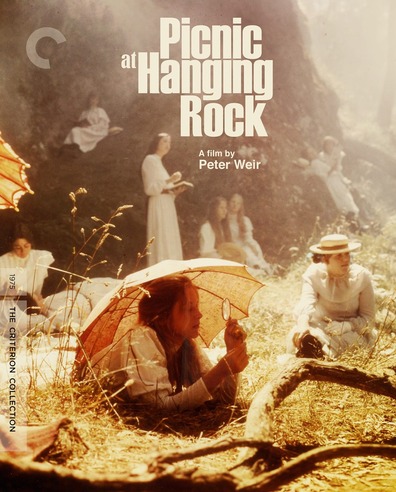
Picnic at Hanging Rock [4K UHD]
Studio: The Criterion Collection
Apr 18, 2024
Web Exclusive
Photography by The Criterion Collection
![]()
It might not be an overstatement to claim that Peter Weir’s Picnic at Hanging Rock is one of the most haunting films ever made. Sure, the 1975 film lacks all the stereotypical elements of the horror genre, like jump scares or dimly lit settings. But, the unsettling, intruding nature of the film’s plot, style and themes are enough to make the experience stick with you long after the credits roll.
Set in 1900 in Australia, Picnic at Hanging Rock follows a group of young students at a small, all-female boarding school that emphasizes proper etiquette and rule-following more than anything else. On Valentine’s Day, all the schoolgirls—except one—take a field trip to Hanging Rock, a hulking, volcanic rock formation filled with secret passageways, venomous snakes and many areas of solitude. The girls picnic on a slope, where they’re almost entirely alone—barring the presence of a rich couple and the two gentlemen accompanying them. Suddenly, four schoolgirls decide to go for a walk and explore the rock, leaving their friends and teachers behind. As the four ascend the formation, tensions grow between one of the students and the other three. In a frightened panic, that girl runs back to the group.
Hours later, and hours past their curfew, the field trippers finally return to their school with the news that the three girls have gone missing, as well as one of their schoolteachers. With no idea of what they did on the mountain or where they went, curiosity quickly morphs into obsession as various characters—including the single girl barred from going on the field trip and one of the men on the mountain—try to solve the mystery.
Some of the horror of Picnic at Hanging Rock comes from the film’s narrative and intrigue. As elements of the narrative develop, including the general public’s interest in figuring out what happened to the schoolgirls, the film quickly morphs into an examination of the ways in which obsession can completely take over one’s mind, throwing logic out of the window for theories and opinions on what could have transpired. There’s a constant, chilling sense that the schoolgirls’ fates have already been decided from the moment they chose to go on their walk. In this sense, despite everyone’s collective desire to know what happened, it’s clear that any attempts to solve the mystery will come up short, making characters’ more drastic and dangerous actions all the more frightening.
But, the real horror of Weir’s film is how the director frames the story. The director’s visual style is filled with various oddities–such as unsettling camera pans when capturing the rock or zooming in/out on character’s faces to capture their strong expressions. Furthermore, the filmmaker weaponizes the film’s sound. Especially as the narrative unfurls itself, the filmmaker contrasts moments of silence, the piano-heavy film score and the overwhelming symphony of nature (particularly the screeching of cicadas) to showcase how isolated all of the characters are—from themselves, each other and their surroundings. When characters do talk, the desperation of their voice and tone often increases the contrast between them and these other noises. As such, despite conversational dialogue being spaced out or completely abandoned during many of the film’s sequences, Picnic at Hanging Rock is always sonically overwhelming.
Picnic at Hanging Rock is one of the best examples of the successful fusion of form and content. The combination of the film’s narrative, visual language and lack of complete sonic cohesion constantly build on one another to evoke a specific, gut-wrenching feeling within the spectator, even before the girls go missing at the end of the film’s first act. As the film’s tension increases, the strength of the relationship between these three elements increases, amplifying the feeling of dread and trepidation. The story is horrifying, yes. But because of how successfully Weir commands the film’s elements, the experience of watching the story unfold is much scarier.
The Criterion Collection’s re-release and 4K upgrade of Picnic at Hanging Rock is necessary and well worth a purchase. Along with the new 4K restoration—which perfectly brings out the film’s crisp contours and bold, summery hues—the physical edition includes many supplemental features. Among the best: an on-set documentary capturing the experience and process of making the film, one of Weir’s short black comedies and an interview with Weir. For fans of Weir’s work, fans of different types of horror films or those interested in seeing how one’s expectations of a film can so easily be subverted, Picnic at Hanging Rock is a must-watch.
(www.criterion.com/films/565-picnic-at-hanging-rock)
Current Issue

Issue #72
Apr 19, 2024 Issue #72 - The ‘90s Issue with The Cardigans and Thurston Moore
Most Recent
- 10 Best Songs of the Week: Nilüfer Yanya, Linn Koch-Emmery, Fat Dog, Crumb, St. Vincent, and More (News) —
- Fat Dog Announce New Album and Tour, Share Video for New Song “Running” (News) —
- The Obsessed, Howling Giant @ Brooklyn Meadows, NYC, April 12, 2024 (Review) —
- Premiere: Slow Joy Releases New Single and Video for “King Cowboy” (News) —
- Premiere: Mackenzie Shrieve Shares New Single “Didn’t I Tell Ya” Feat. Jane Bruce (News) —

Comments
Submit your comment
There are no comments for this entry yet.